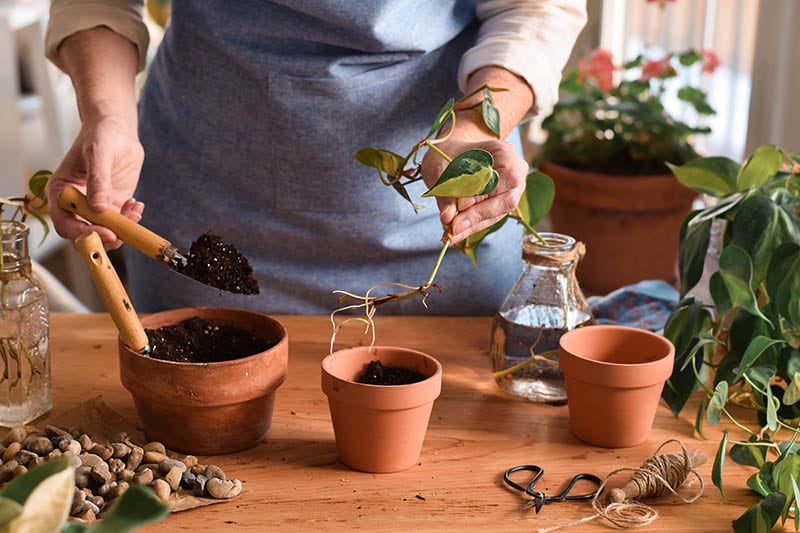How to Make Potting Soil for Pothos Plants (Step-by-Step Guide)
-
Pete Ortiz
- Last updated:

Pothos are a type of trailing plant that are most commonly grown as indoor pot plants. Given the right environment, these plants can grow quickly, and this means providing them with a humid and warm environment. Having the right potting soil also helps and is especially important to ensure that your pothos has adequate drainage. Leaving this type of plant in poor-draining soil can encourage root rot which may ultimately kill the plant.
The soil your plant grows in is important for nutrients and food, as well as drainage. Pothos prefers a slightly acidic soil with a pH between 6.1 and 6.8. If you are buying a potting soil, make sure it contains something like perlite or peat moss to aid in drainage. And because pothos is a fast and constant grower, you will need to ensure that it has adequate nutrients by providing it with liquid food on a fairly regular basis.
Read on for more information on making your own pothos potting soil and other tips to help ensure that your trailing plant thrives.
Some of the topics discussed in this article:

About Pothos Plants
The pothos plant is described as being low maintenance and easy to care for. This is likely because, given the right conditions, it will thrive and grow quickly. It can also do well in a good variety of different climates and environments and although it does benefit from nutrient-rich soil, it can also grow very well in soil with little to no nutrients. It is nicknamed Devil’s Ivy because it can grow so vigorously and because it will survive even the most challenging conditions.
However, as low maintenance as they are, pothos do still need certain growing conditions to ensure their survival and to give them the best chance of growing strong and healthy.

How To Grow Pothos
Pothos can be grown in low light conditions which makes it a good choice for offices and bathrooms. In fact, the humidity in the bathroom makes this a very good location for a pothos plant.
Choose a pot with drainage holes at the bottom and either buy a suitable potting soil or make your own using the guide below. While the plant does do well in hanging baskets, it has aerial roots which it uses to grip onto branches and even walls, and these can cause damage to paintwork so you will have to monitor the plant as it grows to ensure that it isn’t damaging the décor.
Water the soil when it feels dry, do not overwater, and apply a liquid fertilizer once a month for the best-growing results. If you want a bushier pothos, rather than a straggly hanging ivy, you can prune it back. Cut just above a leaf, and definitely remove spotted leaves.
How To Make Potting Soil for Pothos Plants
One of the key aspects to ensuring good growing conditions for pothos is choosing the right soil. There are some good commercial potting soils that are suitable, or you can make your own.
Mix bark, coco coir, perlite, activated charcoal, and worm castings in the following ratio and mix everything together well to get a potting soil with suitable drainage levels:
- 5 parts bark
- 5 parts perlite
- 4 parts coco coir
- 2 parts worm castings
- 2 parts activated charcoal

Are Pothos Plants Poisonous?
Pothos plants are considered mildly toxic. All parts of the plant, including leaves and stems, contain calcium oxalate. These can cause burning and discomfort, as well as swelling in the mouth and throat if swallowed. The plant is not only toxic to humans but to cats and dogs, as well, so be careful with this one if you have pets.
How Can I Make My Pothos Grow Better?
To enjoy the best possible growth, you need to provide optimal conditions. Pothos will grow in a good range of conditions, including in low light, but it prefers partial sun and benefits from a warm, humid environment. Similarly, it can survive in nutrient-poor soil but benefits from having a regular liquid fertilizer feed. Also ensure that you prune any spotted leaves and any brown roots from the plant, to encourage new growth. And when pruning, prune above the leaves of the vine.
How Much Sun Does a Pothos Need?
Pothos can survive in low indirect light conditions, but they prefer to be given bright, indirect light. However, it does not enjoy direct sunlight, so avoid putting it in windows that get a lot of sunlight during the day.
Do Pothos Like to Be Misted?
Pothos do not need misting, and misting them may actually do more harm than good. Water droplets left on the leaves can encourage pests, while the misting doesn’t do anything to improve the surrounding humidity levels that pothos really benefit from.
Conclusion
Pothos are popular houseplants and are nicknamed Devil’s Ivy because they grow rapidly and can be resurrected even when they are given poor growing conditions. The plant can grow in low light but prefers indirect light. It can also grow in nutrient-poor soil but prefers nutrient-rich soils.
One area where you can’t compromise is the type and makeup of the potting soil. Pothos need soil with good drainage, which means adding perlite and bark to a standard potting soil or buying special soil designed for this type of plant.
Featured Image Credit: JulieK2, Shutterstock
Contents

